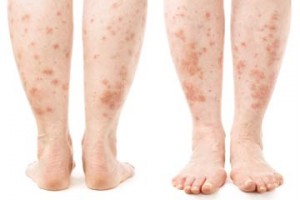Rashes in children appear as changes in skin colour or texture. Rashes in children may be generalized or localized depending on the cause of the condition. A localized rash refers to a rash affecting only a single part of the body, whereas a generalized rash may appear on several areas of the child’s body. Common causes of rashes in children include allergies, cradle cap, eczema etc.
Common symptoms of rashes include red, brown, purple or white skin which may be raised, moist, pale, dry, crusted, scaly or pale. Sometimes children may also exhibit symptoms such a hives, 
Important Disclaimer: this post on rashes in children is for information purposes only to learn more about rashes and complications that can be associated with them enrol in workplace approved first aid training. Consult your doctor if you have a serious rash or any other complications.
Causes
- Athlete’s foot
- Allergies
- Cradle cup
- Cutaneous larva migrans
- Diaper rash
- Eczema
- Poison ivy
- Irritant dermatitis
- Erythema toxicum – common in infants
- Scabies
- Ringworm
- Tinea capitis
- Viruses – roseola, mononucleosis, fifth disease
The following are rare causes of rashes:
- Erythema multiforme
- Chicken pox
Bacterial infections that may cause symptoms such as rashes include:
- Cellulitis – of the face, ear, hand, leg, foot, abdomen, breast
- Impetigo
- Lymphangitis – of the arm, hand from finger wounds, back of the leg
- Meningococcemia
- Scarlet fiver
- Skin abscess
Signs and symptoms of rashes in children
- Blisters
- Skin color changes – red, white, black, brown
- Dry skin
- Changes in the surface of the skin – skin may be raised, flat, scaly, dry, crusty, moist, peeling
- Hives
- Skin bumps or lumps
- Swelling of the skin
- Pus drainage
- Skin tenderness
- Skin ulcers
If you take your child to a pediatrician, he may treat your child depending on the cause of the rash. Treatment of rashes in children generally involves taking medicated baths, oral corticosteroids, corticosteroid creams, skin moisturizers, antihistamines to treat itching, antibiotics and phototherapy.
Treatment
Follow these treatment steps if your child is suffering from skin rashes:
1. Find out the cause of the rash
- The rash may be caused due to certain triggers or irritants such as poison ivy, irritating chemicals, detergents, soaps or an animal or pet
- The rash may also be a diaper rash that occurs if your child’s diapers are not changed frequently. Make sure you change your child’s diapers regularly and apply protective cream after cleaning the area in order to prevent diaper rashes. See your doctor if your child is still having diaper rashes
2. Clean the affected region of the skin
- Wash the affected skin with the rash with water and mild baby soap. Avoid scrubbing the rash. Wash with warm water
- Do not rub the skin with a towel, gently pat the skin dry with soft material
- Do not cover the rash with anything
3. Treat symptoms of the rash
- Cut your child’s fingernails and make him wear gloves or mittens to prevent scratching
- Place a wet cloth on the rash to reduce itching and pain
When to seek medical help
See your doctor if:
- Your child has a fever
- The rash goes past the diaper area
- The rash is wet, red or is oozing out liquid – this may be a sign of infection
- Rash appears in skin creases
- Rash remains persistent even with home care treatment
- Your child looks ill or is not feeding well
- Your child has hives or bruises due to injury
- Rash appears flat with small red spots
Learn More
To learn more about basic first aid and child care first aid enrol in a workplace approved program near you (register for a course here).
Related Video
http://www.youtube.com/watch?v=6WFi1UAY5Zg
